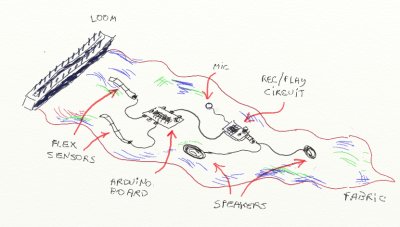 |
||||||
|
Links
|
Telar Calchaquí (Calchaquí Loom) This piece is part a sculptural object, and part a performance work. A Calchaquí loom was used to knit a long piece of textile were electronic components to play and record sounds were embedded into. Spectators of the performance were invited to sit next the artist and to knit together with him. The conversations that ensued were recorded - literally "knitted into the piece" - and later played back when the performance was over. This type of loom was used by the Calchaquí people (spanish wikipedia page, britannica entry), aboriginal inhabitants of the Andean region of South America. Perceiving myself simultaneously alien and related to these cultures, I recontextualized the loom as a device to question my own identity and perceptions of time. Different layers of meaning were constructed by meshing together traditional crafting techniques with electronic devices: identity and alienation, gender roles and stereotypes, multiplicity of perceptions (visual, auditive, tactile), technology and craft. This work should be understood as an ongoing process. Thanks to Xárene Eskandar for the knitting lessons and Jihyun Kim for her help during the installation. Pictures (click to enlarge)
Video (click to download/play) This video is just a slideshow of pictures taken during the performance done at the EDA gallery in April 3-4, 2008. The audio track contains excerpts of the conversations between the artist and spectators, as recorded by the "knitting" device. Telar Calchaquí | Segundo Movimiento (2nd movement) As it was said before, this piece can be seen as work in (constant) progress. This, in fact, is one of its most relevant aspects: the loom itself is constantly attached to the piece, so the knitting could potentially continue "forever". Hence, the perpetual character of the project is manifested. In this regard, the piece will incorporate different elements as it grows in temporal and spacial extension. These elements will reflect changes in the perception and interests of the artist(s), as well as changes in their environment and situations. In collaboration with Argentinean artist Violeta Cincioni (resume), a second movement for the piece is being created. This new instance looks on to further explore the participative component of the piece by means of converting the fabric itself into a musical instrument. The fabric that will be knitted from now on will contain flex sensors and other devices to measure movement, touch and pressure. When the fabric is manipulated by the spectators, the changes detected by the sensors will be used to modify the sounds that are emitted by the loom. Initially, the loom only recorded the sound of the environment "as it was", without adding any modification or distortion. Now, further dimensions of meaning and expression will come into being with the ability of modifying and distorting the recorded sounds: playfulness, the unexpected, transformation of sounds into music... The voices can be amplified, repeated, altered in different ways according to how the fabric is manipulated and "touched". The loom does not only "knits" the sounds in its fabric, but the fabric and its motions serve as the generator of new rhythms, structures and sounds. Sketch (click to enlarge)
Sketch of the "2nd movement" of the piece. Flex sensors connected to an Arduino board will measure motions in the fabric. These measurements will be used to create a signal from the Arduino to the audio circuit in order to distort the playback of the recorded sounds. The whole system will be self-sufficient, there is no need of an external computer to be attached to any of the electronic components embedded in the fabric. Risk of fire is minimal since the voltages that circulate through the circuits are very low. Other media artists working with textiles Newsknitter, by Ebru Kurbak and Mahir M. Yavuz. From Kunstuniversität Linz. Neoplastic knitting, by Silvia Rigon. Former MFA student from Design|Media Arts. Gelsomina, by trikoton. Showed at Ars Electronica 2007. Moor, rope sculpture by Janine Antoni. Featured in the Art:21 program by PBS. |
|||||
| Andrés Colubri's webpage
:: andres.colubri@gmail.com |
||||||






